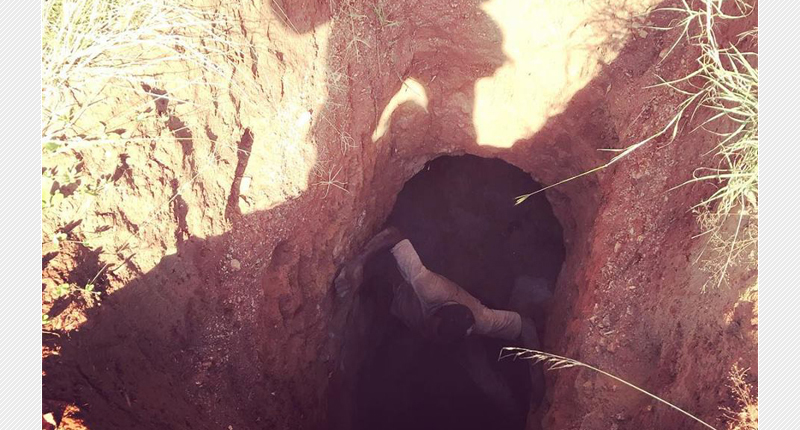The couple pleaded guilty to concealing at least $127 million in cash transactions at its precious metals businesses.
What It’s Like to Be a Field Gemologist, Part 2
Vincent Pardieu talks the green gem he’ll focus on this year, how the sector can work with conservation efforts and the knowledge many are lacking.

Vincent Pardieu has established a career that sees him jetting around the world to gather gemstones from the source for industry laboratories. To hear him tell it, it’s tough, important work that can also take him to interesting places and allows him to meet fascinating people.
In the second part of a two-part Q&A with the field gemologist, we talk about memorable moments in his career, where it could take him next and challenges in the market today.
(Revisit the first half of our conversation here.)
National Jeweler: Is there a project or trip that is particularly memorable to you, whether that’s for a good or bad reason?
Vincent Pardieu: Mozambique is a very special place to me because that currently is the world’s leading source for rubies. I went to Mozambique at the very beginning. I was the first foreigner, the first gemologist, to be able to visit it and I have visited this ruby deposit every year since.
But it’s not just that. It’s these stories that happen to me. I was able to meet the people from the ruby deposit in Montepuez because of people from the Niassa Reserve, so then I started to collaborate with the people from the Niassa Reserve. They are conservationists. If I want to go to an area that is dedicated to conservation, I have to ask them for permission.
I started collaborating with them and gained some interest in the Niassa Lion Project. Now, every time I go to Mozambique, I go to visit the ruby mine and I also go to visit Niassa to understand the interaction between mining and conservation because I was able to see that, in some cases in Africa, you have some discoveries of gemstones inside areas dedicated to conversation.
Sometimes it turns out to be a win-win situation because the miners and the people in charge of conservation collaborate. But in other cases, it’s a total disaster because they have conflicts.
I was able to see some very positive stories, for example in Kenya, where you have mining inside Tsavo National Park. I was able to meet Campbell Bridges during my first visit to Africa in 2005, and I was very impressed to see that he named a stone after the national park and was mining these stones just inside Tsavo and trying to support conservation in this area, helping
But that’s not always the case. Like recently in Madagascar, where you have some sapphire discoveries inside one of the last protected forest areas, you have thousands of miners invading the protected area and now there is a direct conflict between the conservationists trying to protect this area and sapphire traders and miners.
So I’m trying to help find some solutions because, from what I see, in some areas conservation and gem mining can work together, and there are some opportunities for the gem trade and conservation to collaborate, but if there are conflicts, I think it can be very dangerous for the gem trade because we are making enemies that we don’t really want to make.
NJ: So in these situations, you’re sort of playing a role where you are also trying to help figure out how to branch the two, as well as doing the field research?
VP: Yes. Because I need to speak with them in order to access these areas. When I go to an area, I go to see the authorities, and sometimes there are some security issues so I have to ask for permission. And of course, every time I speak with the authorities, they ask me my opinion (about the mining sites), because very regularly I see that the guys in charge never have visited the sites. So I try to convince them to, No. 1, let me go, and maybe let me go with some policemen or some technicians.
Then I come back and I tell them what I have seen. The whole time there is collaboration because I need to get access and be able to collect some samples, and in exchange I provide them with information and with some advice.
NJ: Is there anywhere you haven’t been or any projects you haven’t started yet that you would still like to do?
VP: There are a lot of places. During the past eight years for GIA I focused on rubies and sapphires, but this year I think I will focus on emeralds. I plan to visit quite a lot of emerald deposits in the coming year, so probably go to Brazil, Colombia and some other emerald sites I haven’t visited yet, like Madagascar and Austria. I visited some emerald mines when they were close to the ruby and sapphire mines. Emerald was my priority No. 3, and now it’s becoming my priority No. 1.
There are plenty of countries where I haven’t put my feet and with this focus on emerald, I will be able to find a good reason to go there. That will be fun.
NJ: To take a broad look at the market, from your perspective, what are some of the biggest challenges that the colored gemstone sector faces today?
VP: There are multiple. There is always the challenge that most people understand very, very little about colored stones and they have a very limited knowledge about colored stones, so this creates an opportunity for some to take advantage of the lack of knowledge.
(Specifically I’m talking about) technical knowledge about, for example, synthetic treatments and how to speak about treatment. The trade still doesn’t know how to speak about treatment. They are trying to avoid it because treatment sounds bad. Many people in the trade are afraid to speak about treatments so they prefer not to, so (the challenge is) how to handle treatment, how to communicate about treatment, how to explain to the customer that treatment is not always a bad thing.
“The trade still doesn’t know how to speak about treatment. They are trying to avoid it because treatment sounds bad. Many people in the trade are afraid to speak about treatments so they prefer not to.”For many mining areas now, you need treatment. If you don’t have treatment, only maybe less than 1 percent of the production would be able to find a market. But I don’t know any business that can survive with 1 percent of production. If there is a mining area that is active, it’s probably because there is a treatment. And, actually, untreated stones are a byproduct of mining for a stone that will be treated.
For example, rubies; to find rubies that don’t need heat treatment, there might be one stone like that out of 100. But if the 100 don’t find a market, it will not be profitable for the miner to work the project.
It’s very difficult. The miners have to be able to sell their daily production to be able to survive. Most of the miners don’t have enough capital to survive until they get an exceptional stone. Mining is not about getting exceptional stones; it’s about getting some stones and then from time to time, there will be an exceptional stone. This is one of the difficulties the trade has.
Also, speaking about origin; origin is complicated because there are many different labs with different opinions. Some labs are not doing research, some labs are. But they still all have an opinion. And the final customer has the problem of figuring out which labs they should trust the most.
For colored stones, it’s complicated because you have a great variety of choice—so many stones and so many colors. Many people feel lost because they don’t know who to trust, they feel like there’s so much to learn and they don’t know enough so maybe they should think about buying something else. How to maintain the trust in the product—I think the colored stone sector has a lot to improve in that area.
The Latest

Consumers shared concerns about prices, inflation, tariffs, trade, and politics in the survey’s write-in response section.

In February 2026, the auction house will move its headquarters to the former Steinway Hall, a neoclassical landmark on Billionaires’ Row.

How Jewelers of America’s 20 Under 40 are leading to ensure a brighter future for the jewelry industry.

The new show will take place Jan. 23-25, 2026.


The former BHP Billiton leader and Gemfields chairman is remembered for his influential leadership throughout his 50-year mining career.

The LVMH-owned brand has partnered with the costume design union to revamp its award for 2026.

Roseco’s 704-page catalog showcases new lab-grown diamonds, findings, tools & more—available in print or interactive digital editions.

The luxury titan inked a deal to acquire an initial minority stake in the jewelry manufacturer with a pathway to full ownership by 2032.

The company’s curation of unsigned vintage and estate jewelry debuted at the Bloomingdale’s in Costa Mesa, California.

In the recent multi-shipment seizure, CBP also found counterfeit Audemars Piguet, Moncler, and Chrome Hearts items.

Jewelers of America execs and National Jeweler editors discuss tariffs, the sky-high gold price, and the engagement that broke the internet.

The luxury goods company said founder Ippolita Rostagno will remain at the brand’s helm.

Laura Burdese, who joined the Italian luxury brand in 2022, will take on the role in July.

Need a gift for the cat lover who has everything? Look no further than our latest Piece of the Week.

It purchased the “Grosse Pièce,” an ultra-complicated Audemars Piguet pocket watch from the ‘20s, for a record-breaking price at Sotheby’s.

The lab-grown diamond grower now offers custom engagement and fashion jewelry through its Kira Custom Lab Jewelry service.

Chandler got his start at Michelson Jewelers and has served as DCA president and CEO since 2001. He will retire at the end of the month.

The boutique is slated to open this week inside Terminal 8, offering pre-owned Rolex watches and more to international travelers.

Sponsored by Digital Monitoring Products

The special-edition egg pendant ingested in a New Zealand jewelry store was recovered after a six-day wait.

Associate Editor Natalie Francisco plays favorites with Piece of the Week, selecting a standout piece of jewelry from each month of 2025.

The “Love and Desire” campaign is inspired by the magic that follows when one’s heart leads the way, said the brand.

Two awardees will receive free tuition for an educational course at the Swiss lab, with flights and lodging included.

Berta de Pablos-Barbier will replace Alexander Lacik at the start of January, two months earlier than expected.

Sotheby’s held its first two jewelry sales at the Breuer building last week, and they totaled nearly $44 million.

Winners will receive free registration and lodging for its fourth annual event in Detroit.






























